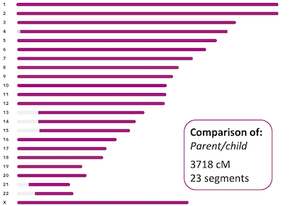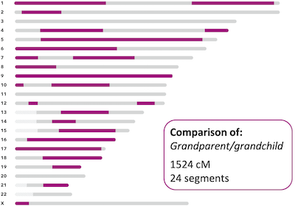
The Quest is Ongoing
This month has been both fulfilling and frustrating. With more than 100,000 DNA matches, it is a struggle to identify relationships for my own DNA test not to mention my efforts to properly manage two additional tests.
That being said, the process of investigating the matches and
learning about my relatives is filled with both boredom and with
occasional glimpses of some really fascinating lives.
In addition to this ongoing quest to identify my DNA matches
relatives, I am also dedicated to breaking down the critical brick walls
that have blocked completion of five distinct lines of descent. These
efforts have been detailed in a few prior columns. This month I've
focused on attempting to identify the biological father of the woman who
gave birth to my first grandchild. The exciting news is that I've had a
breakthrough.
The closest non-paternal match for my grandson's DNA test was
identified generically as a solid 1st or 2nd cousin. For those of you
familiar with DNA testing, you will know matches are listed by what is
statistically the most common relationship. However, as I've written
before, depending upon the number of centiMorgans, the length of
matching segments, and the percentage assigned the match, multiple
possible relationships exist.
In this case, the close match reveals 1st – 2nd Cousin |
Mother's side13% shared DNA: 917 cM across 34 segments. Sound like
Greek? Let me provide some information.
Source: https://www.genome.gov/genetics-glossary/CentiMorgan (Christopher P. Austin, M.D.)
A centiMorgan is a unit used to measure genetic linkage. One centiMorgan equals a one percent chance that a marker on a chromosome will become separated from a second marker on the same chromosome due to crossing over in a single generation. It translates to approximately one million base pairs of DNA sequence in the human genome. Source: https://www.genome.gov/genetics-glossary
CentiMorgan is named after an American geneticist named Thomas Hunt Morgan. He worked on fruit flies, and he defined the capacity of one part of a genome to separate from another in going from one generation to another. And that's important because in every generation chromosomes exchange pieces of information, and that's called recombination. And that's important for introducing genetic diversity into the population. And it was necessary to define a rate at which this happens, and so that's where this term centiMorgan comes from. "Centi" means just one-hundredth of, and so if a "Morgan" represents the total recombination where all markers of one part of a chromosome will become separated from all others, then a centiMorgan is the length of DNA over which that happens only one out of a hundred times, or one percent of the time. So one percent recombination equals a centiMorgan. It depends on individual genomes what the distance that a centiMorgan represents, and in individual genomes is different from fruit flies and zebrafish and bananas and humans, but given the recombination rate in humans, it represents about a million base pairs in the human genome.
Source: https://www.genome.gov/About-Genomics/Introduction-to-Genomics
What's a Genome?
Genome is a fancy word for all your DNA. From potatoes to puppies, all living organisms have their own genome. Each genome contains the information needed to build and maintain that organism throughout its life.
Your genome is the operating manual containing all the instructions that helped you develop from a single cell into the person you are today. It guides your growth, helps your organs to do their jobs, and repairs itself when it becomes damaged. And it’s unique to you.
DNA testing has become the subject of many television shows,
movies, and books not to mention the proliferation of websites providing
avenues for personal elucidation regarding your genetic makeup and
relation to matching tests.
But, DNA is tested for many purposes. Here is a synopsis of those tests and their use:
What is genetic testing?
Genetic testing consists of the processes and techniques used to determine details about your DNA. Depending on the test, it may reveal some information about your ancestry and the health of you and your family.
Predictive testing is for those who have a family member with a genetic disorder. The results help to determine a person’s risk of developing the specific disorder being tested for. These tests are done before any symptoms present themselves.
Diagnostic testing is used to confirm or rule out a suspected genetic disorder. The results of a diagnostic test may help you make choices about how to treat or manage your health.
Pharmacogenomic testing tells you about how you will react to certain medications. It can help inform your healthcare provider about how to best treat your condition and avoid side effects.
Reproductive testing is related to starting or growing your family. It includes tests for the biological father and mother to see what genetic variants they carry. The tests can help parents and healthcare providers make decisions before, during, and after pregnancy.
Direct-to-consumer testing can be completed at home without a healthcare provider by collecting a DNA sample (e.g., spitting saliva into a tube) and sending it to a company. The company can analyze your DNA and give information about your ancestry, kinship, lifestyle factors and potential disease risk.
Forensic testing is carried out for legal purposes and can be used to identify biological family members, suspects, and victims of crimes and disasters.
In prior columns your author has explored exciting advances and
successful identification and prosecution of violent criminals. The
recent identification, arrest, and prosecution of one of America's most
prolific rapist/murderers known by several monikers but most recognized
as the Golden State Killer was covered in this prior column:
Armchair Genealogy on Pencil Stubs Online, pencilstubs.com
Remember: "A centiMorgan is different from the physical
units we use in everyday life, such as inches or kilometers. It is less
of a physical distance and more of a measurement of probability. It
refers to the DNA segments that you have in common with others and the
likelihood of sharing genetic traits. The ends of shared segments are
defined by points where DNA swapped between two chromosomes, and the
centiMorgan is a measure of the probability of getting a segment that
large when these swaps occur." Source: https://www.familysearch.org/blog/en/centiMorgan-chart-understanding-dna/
As has been said, the greater the number of cMs and segment
lengths, the closer the relationship. Also, the possible relationships
are fewer as the cMs increase.
The cM measurement is actually given as a sum of all the
various segment lengths that match. The closer the relationship, not
only will the combined length of all segments be greater, but the
lengths of the individual segments will be greater.
In one example, two charts demonstrate that definition.
pic

|
Source: https://genetics.thetech.org/ask-a-geneticist/centimorgans-vs-shared-segments
Here you see a typical Parent/Child relationship where 23
matching segments are lengthy and, when combined, add up to 3,718 cMs.
When one considers that 3.2 BILLION base pairs containing
some 30,000 genes make up the human genome thus creating our 23
chromosomes, we can begin to comprehend the complexity of our genetic
constitution. Another factoid:
CentiMorgans: length of DNA
The length of a piece of DNA is measured in centiMorgans. The total length of all your chromosomes combined is around 7400 cM.
Since a person inherits half of their DNA from each parent,
you share about 3700 cM with each parent. The exact number for each
parent/child relationship can vary slightly, but not by a lot.
Each human inherits 50% of their genetic makeup from each
parent, each of whom similarly inherited 50% from each of their parents
... meaning you will inherit roughly 25% of your genetic makeup from
your grandparents.
The following illustrates a typical DNA result for Grandparent/Grandchild test:

|
Source: https://genetics.thetech.org/ask-a-geneticist/centimorgans-vs-shared-segments
Given all this complex information concerning DNA test results,
it requires more than the test result numbers to substantiate a
confirmed relationship given ONLY the numbers.
All this to introduce my recent breakthrough investigating
the close (VERY close) DNA match for my grandson. There are several
possibilities as defined by Ancestry:
"Possible DNA relationships"
This table shows the percentage of the time people sharing 917 cM have the following relationships:
Percent Relationship
99%
1st cousin
Great-grandparent
Great-grandchild
Grandaunt/granduncle
Less than 1%
Grandparent
Grandchild
Half sibling
Aunt/uncle
Niece/nephew
Less than 1%
1st cousin 1x removed
Half 1st cousin
2nd great-grandparent
2nd great-grandchild"
Finally, the breakdown of possible relationships based on centiMorgan quantity came from my DNA matches on Ancestry. Source: Ancestry.com.
Now, it is necessary to examine the match using vital facts,
documents, and LOGIC. Much as detectives must use the scale of Motive,
Opportunity, and Means, to advance a theory of NPE (non-parental event)
mating we genealogists must determine Proximity, Age and Dates, and
Potential commonality. In other words, build a tree, research FACTUAL
documents, and make sure the suspected mystery biological parent shared
time and space with the known parent and that they could logically
expect to have joined with that known parent to produce a child.
That's where I now find myself - at the crossroads just in
advance of naming the suspected father! Stay tuned, I shall write a few
notes to the closest Shared Matches in an attempt to gain knowledge
through personal stories should I be fortunate in making contact. In the
meantime, please take advantage of your opportunity to do your own
Armchair Genealogy.





No comments:
Post a Comment